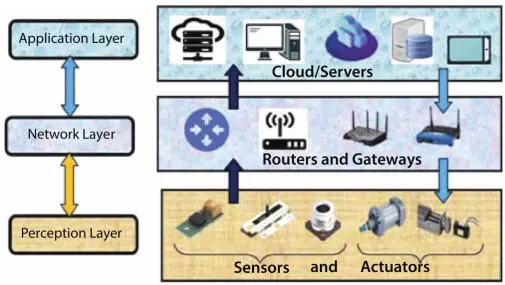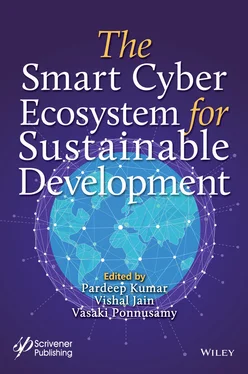Such a phenomenon in the 2000s was heading into a new era of ubiquity, the fact of appearing everywhere internet connectivity is not only serving for Anywhere, Anytime but it also gives the surface of connecting Anything. So, this concept will remove a separation between the real world (physical world) and an imaginary world (internet) resulting that real-world interest should be able to get access to online. In this online access, human beings are very less as internet traffic generators and receivers compared to the things (devices) around us. So, as per the Gartner Research, we can define IoT as, “ The Internet of Things (IoT) is the network of physical objects that contain embedded technology to communicate and sense or interact with their internal states or the external environment ” [30].
1.1.1 Characteristics of IoT
The applicability and scope of IoT depends on its basic characteristics as given below [2].
Connectivity: Permits network accessibility and compatibility. Compatibility provides the ability to consume and produce data from the network while accessibility is the ability to avail network access.
Interconnectivity: This characteristic of IoT says that Anything around us can be Interconnected and thereby communicated with others.
Heterogeneity: The devices that are used in IoT are different in nature, hardware platform, and other network-related capabilities. Such devices are known as heterogeneous devices that can work together with each other in various networks.
Scalability: In IoT, the amount of devices connected with each other to perform communication is very large, i.e., in millions or even in trillions compared to existing internet. So, in this scenario, it is critical to manage and interpret the generated data that ultimately requires scalable data handling techniques. So, even when internally connected devices such as sensors and other connecting devices increase, it should not affect network performance.
Dynamic: The devices connected with each other in IoT are changing not only their status from connected to disconnected, sleep to wake up but they also update their location as well as speed. Thus, it dynamically updates the number of connected devices.
Safety: As we have discussed, millions and trillions of devices are connected in IoT, so safety for data generators and data recipients is must. Such safety design should be made available to data in network, network endpoints, and network itself with sufficient scaling.
Having such characteristics, IoT architecture can be classified into three different tiers such as Physical Layer, Network Layer, and Application Layer as follows.
Different architectures have been proposed by different researchers for IoT, out of which the most popular architecture is three-layer architecture as shown in Figure 1.1. As per its name, this architecture has three layers, namely, i) Perception Layer, ii) Network Layer, and iii) Application Layer. This architecture basically provides the basic idea of the IoT that is further divided into five-layer architecture [2, 5, 20].
The Perception Layer is also known as a physical layer that consists of sensors and actuators. Sensors sense information from the surrounding environment and actuators actuate, i.e., perform some actions based on its sensing from the environment. So, actuators are mechanisms that control the system and accordingly act in the environment. So, basically, this layer provides/acts as input to the IoT architecture.
The Network Layer acts as an intermediate layer that provides communication between perception layer and network layer using communication devices such as routers and gateways. The basic task of this layer is to connect smart devices and its related servers. As an intermediary layer, it also transmits and processes the input data of sensing devices received from the perception layer.
The Application Layer defines various applications in which IoT is deployed. This layer performs application specific tasks and delivers service accordingly. The specific application may be smart farms, smart homes, smart cities, etc.

Figure 1.1Three-layer IoT architecture.
Furthermore, this three-layer architecture converts into five-layer architecture. In this architecture, the perception layer and application remains and acts the same but the intermediate network layer is again divided into three sub layers such as Transport Layer, Processing Layer, and Business Layer. In this five-layer architecture, the transport layer transmits sensor data from perception layer to processing layer. Processing layer acts as a middleware layer and it can store, analyze, and process data that was received from the transport layer. To do such a task on data, this layer basically deals with many other data management technologies such as Big Data computing to process, cloud computing to store, and database management system to manage the data. The Business Layer acts on the top of the application layer and manages the entire IoT system. It consists of all application-related information such as profit model of business to that application, user privacy to the specific application, and other such business application-related information. Based on this architecture, the merits and demerits of IoT are as follows.
1.1.3 Merits and Demerits of IoT
Merits and Demerits of the IoT are as mentioned below:
Merits:
✓ Access Information: Due to association of cloud computing technology with IoT, the data access of the IoT is easy and available anywhere, anytime. So, a person involved in IoT can have easy access to such information and thereby without having his/her physical presence, it makes it convenient for that person to go about their work.
✓ Communication: IoT has important characteristics such as Interoperability. Using such characteristics, devices involved in IoT can easily talk to each other. In this way, inter-device communication will be more transparent and thereby increase efficiency of connected devices, e.g., a production unit comprises IoT technology, has Machine-to-Machine (M2M) communication that makes the product better by reducing inefficiencies, and produces faster results.
✓ Cost Effective: This merit is actually a combined benefit of the above two merits. Due to easy information access and communication, IoT devices can transmit the data very quickly over a connected component in the network of IoT. So, it saves time compared to traditional data transfer in which it occupied much more time and in that way IoT became a cost effective solution.
✓ Automation: It means to manage routine work without any human intervention. IoT helps in business automation and improves the quality product or service. IoT can collect data from the network and perform analytics on it to reveal business insights and opportunities, and thus reduce operational cost. In the automation process, IoT can also predict needs before they arise and take action accordingly to gain business profit.
Demerits:
Privacy and Security: IoT is an inter-network of things that consists of multiple devices interconnected to each other. So, such interconnection might increase the risk of any leakage of important data. In this scenario confidential information may not be safe and could be fetched/hacked by someone else easily.
increase the risk of any leakage of important data. In this scenario confidential information may not be safe and could be fetched/hacked by someone else easily.
Complexity: IoT is not only a collection of interconnected heterogeneous devices but also a combination of heterogeneous networks. So, in this environment, a single ambiguity can affect the entire system tremendously. This certainly creates a complicated state of affairs and easily increases complexity.
Читать дальше













